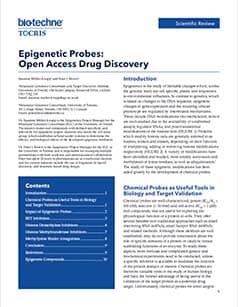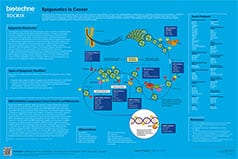Class IV HDACs
Class IV proteins contain one member, HDAC11, which is involved in regulating protein stability of DNA replication factor CDT1 and interleukin 10 expression.
Class IV HDAC Inhibitors |
|
|---|---|
| Cat. No. | 产品名称/活性 |
| 7969 | SIS17 |
| Selective HDAC11 inhibitor | |
HDAC classification
| Superfamily | Family | Class | Subclass | Protein (human) |
|---|---|---|---|---|
| Arginase/deacetylase superfamily | Histone deacetylase family | Class I | HDAC1, HDAC2, HDAC3, HDAC8 | |
| Class II | Class IIa | HDAC4, HDAC5, HDAC7, HDAC9 | ||
| ClassIIb | HDAC6, HDAC10 | |||
| Class IV | HDAC11 | |||
| Deoxyhypusine synthase like NAD/FAD-binding domain superfamily | Sir2 regulator family | Class III | I | SIRT1, SIRT2, SIRT3 |
| II | SIRT4 | |||
| III | SIRT5 | |||
| IV | SIRT6, SIRT7 |
Literature for Class IV HDACs
Tocris offers the following scientific literature for Class IV HDACs to showcase our products. We invite you to request* your copy today!
*Please note that Tocris will only send literature to established scientific business / institute addresses.
Epigenetics Scientific Review
Written by Susanne Müller-Knapp and Peter J. Brown, this review gives an overview of the development of chemical probes for epigenetic targets, as well as the impact of these tool compounds being made available to the scientific community. In addition, their biological effects are also discussed. Epigenetic compounds available from Tocris are listed.
Cell Cycle & DNA Damage Repair Poster
In normal cells, each stage of the cell cycle is tightly regulated, however in cancer cells many genes and proteins that are involved in the regulation of the cell cycle are mutated or over expressed. This poster summarizes the stages of the cell cycle and DNA repair. It also highlights strategies for enhancing replicative stress in cancer cells to force mitotic catastrophe and cell death.
Epigenetics in Cancer Poster
This poster summarizes the main epigenetic targets in cancer. The dysregulation of epigenetic modifications has been shown to result in oncogenesis and cancer progression. Unlike genetic mutations, epigenetic alterations are considered to be reversible and thus make promising therapeutic targets.
Histone Deacetylase Gene Data
| Gene | Species | Gene Symbol | Gene Accession No. | Protein Accession No. |
|---|---|---|---|---|
| Class 1 | ||||
| HDAC1 | Human | HDAC1 | NM_004964 | Q13547 |
| Mouse | Hdac1 | NM_008228 | O09106 | |
| Rat | Hdac1 | NM_001025409 | Q4QQW4 | |
| HDAC2 | Human | HDAC2 | NM_001527 | Q92769 |
| Mouse | Hdac2 | NM_008229 | P70288 | |
| Rat | Hdac2 | NM_053447 | Q99PA1 | |
| HDAC3 | Human | HDAC3 | NM_003883 | O15379 |
| Mouse | Hdac3 | NM_010411 | O88895 | |
| Rat | Hdac3 | NM_053448 | Q6P6W3 | |
| HDAC8 | Human | HDAC8 | NM_018486 | Q9BY41 |
| Mouse | Hdac8 | NM_027382 | Q8VH37 | |
| Rat | Hdac8 | NM_001126373 | XP_343805 | |
| Class 2 | ||||
| HDAC4 | Human | HDAC4 | NM_006037 | P56524 |
| Mouse | Hdac4 | NM_207225 | Q6NZM9 | |
| Rat | Hdac4 | XM_343629 | Q99P99 | |
| HDAC5 | Human | HDAC5 | NM_001015053 | Q9UQL6 |
| Mouse | Hdac5 | NM_001077696 | Q9Z2V6 | |
| Rat | Hdac5 | XM_001081495 | Q5RJZ2 | |
| HDAC6 | Human | HDAC6 | NM_006044 | Q9UBN7 |
| Mouse | Hdac6 | NM_010413 | Q9Z2V5 | |
| Rat | Hdac6 | XM_228753 | Q99P97 | |
| HDAC7 | Human | HDAC7 | NM_016596 | Q9UFU7 |
| Mouse | Hdac7 | NM_019572 | Q8C2B3 | |
| Rat | Hdac7a | XM_345868 | Q99P96 | |
| HDAC9 | Human | HDAC9 | NM_058177 | Q9UKV0 |
| Mouse | Hdac9 | NM_024124 | Q99N13 | |
| HDAC10 | Human | HDAC10 | NM_032019 | Q969S8 |
| Mouse | Hdac10 | NM_199198 | Q6P3E7 | |
| Rat | Hdac10 | NM_001035000 | Q569C4 | |
| Class 4 | ||||
| HDAC11 | Human | HDAC11 | NM_024827 | Q96DB2 |
| Mouse | Hdac11 | NM_144919 | Q91WA3 | |
| Rat | Hdac11 | NM_001106610 | XP_238362 | |


